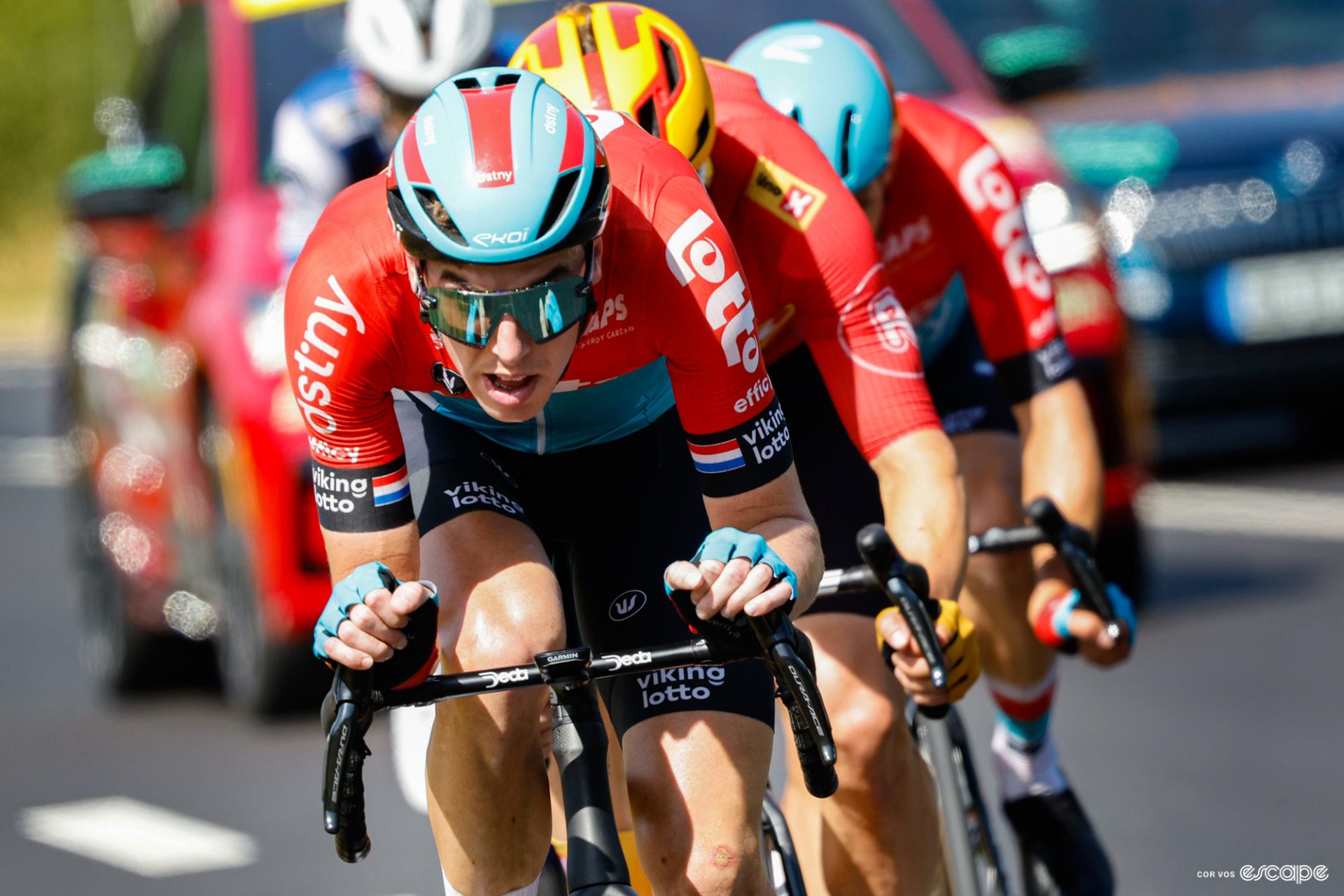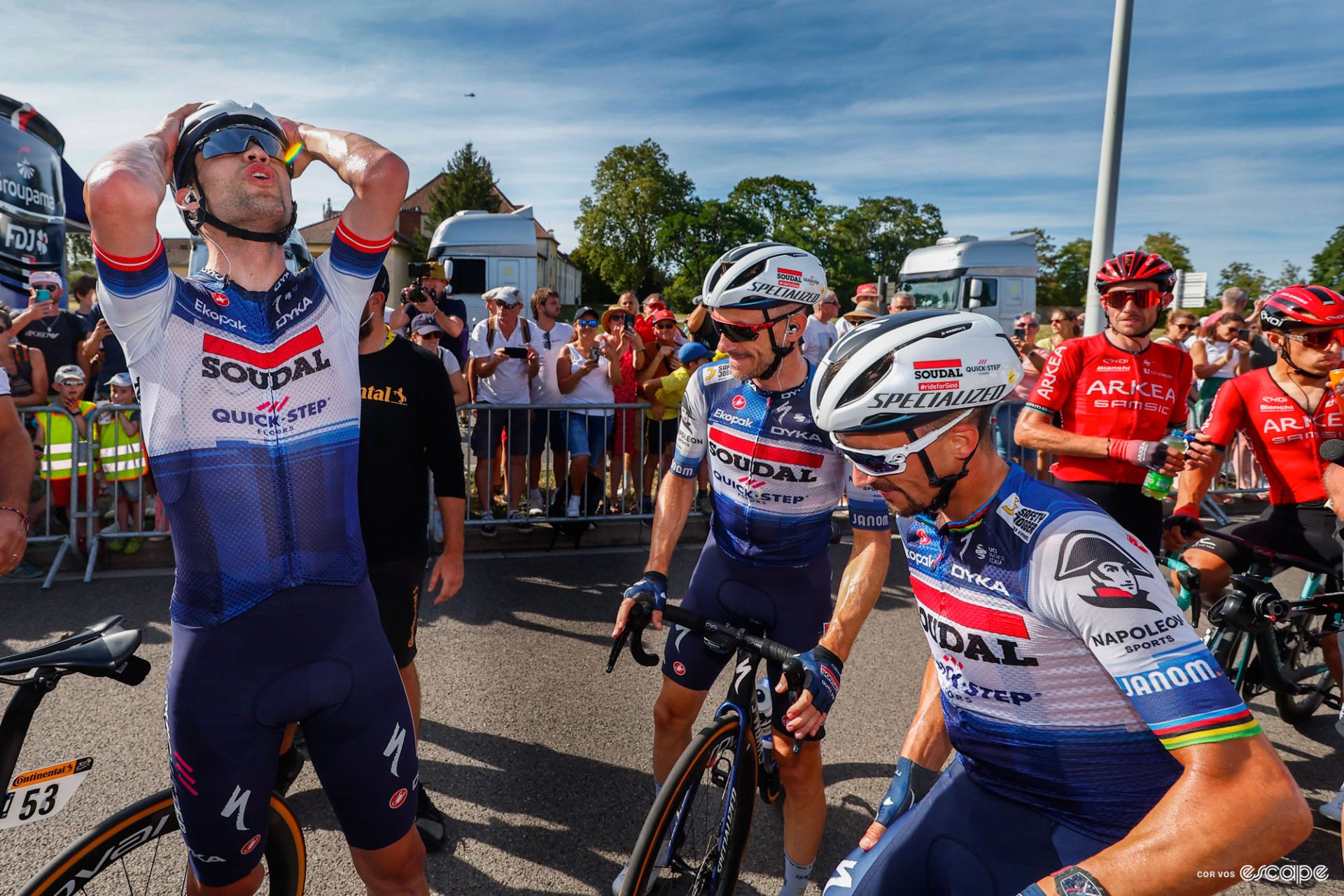Admit it, you didn’t think they would make it. Not at 100 km to go when they had a minute, nor 50k to go, when they had 47 seconds, or 20k to go, when they had 44. Maybe at 10 km, with 22 seconds, the dreamers dared to dream, but nobody else did.
Then came Kasper Asgreen, arms in the air just ahead of a galloping peloton. He took advantage of tired legs, high speeds, and the efforts of Victor Campanaerts.
Inside the peloton, there were early hints of what might come. Around 50 kilometers to go, Soudal Quick-Step began to notice the chase was slowing. “It was a strong breakaway and that’s why I think they never got more than 1’30” maximum, which was not a lot,” said Soudal’s Michael Mørkøv, normally the last leadout for absent sprinter Fabio Jakobsen. “Of course, the sprint teams were nervous. But I think with 50 Ks to go, we could see that they started to explode.”
The deeper we get into a Grand Tour, the more likely these results become. “The fatigue in the bunch plays a big role,” Asgreen said in his winner’s press conference. “At the end of the Tour, especially this year, with all of the really, really hard stages, everybody can just kind of go the same speed but nobody can go much faster. So it can be difficult to catch even a small group that works well together.”

The teams play a game of chicken in this scenario. All need the break to come back, but none want to apply too many resources – their riders – because that will limit their ability to run a good leadout in the finale. So they look at each other. The teams with top sprinters, namely Jasper Philipsen’s Alpecin-Deceuninck and Dylan Groenwegen’s Jayco-AlUla, will only contribute chasers as necessary. They add one rider at a time. Wait to see what happens.
With 20 km to go, it was 47 seconds. All well and good. Bora-Hansgrohe added a few to the chase. The gap came down slowly, ticking toward 20 seconds with 10 km remaining. Still going to plan.
But then the gap froze. The peloton’s tired legs couldn’t overcome the break’s tired legs. Quick-Step stuck Tim Declerq and Julian Alaphilippe in the rotation at the front, but not in the usual chase role: they were disrupting things, buying half a second here and there. At 8 km to go, it was back up to 24. At 6.5, still 23. Bora’s Nils Politt, a mountain of a man, put in an enormous turn, cutting the gap in half. Back on track, it seemed.
Which brings us to Campanaerts. Asgreen now owes the man a favor or two. Lotto Dstny had two in the break, Campanaerts and Pascal Eenkhoorn, and Eenkhoorn has the better kick. So it was Campanaerts on leadout duty.
“The last 5 k, the time was coming down pretty fast,” Asgreen said. “At one km to go, I swung off and saw Victor came to the front and upped the pace to do the leadout for Pascal , and that’s when I believed it was possible.”
He buried himself for the cause.
Tired legs and a dedicated Campanaerts go a long way toward explaining how the sprinters were foiled, but there’s a third element worth adding to the mix. These successful breakaways are increasingly common, and that might come down to something breakaway riders are doing beyond simply pedalling hard. Campanaerts is, in fact, one of the best examples of this phenomenon: the aero weenies of the peloton.
The theory (and it isn’t mine, but I tend to agree with it) goes like this: the power required to overcome aerodynamic drag is cubic to speed, meaning that the additional power (watts) required to go from 55 kph to 57 kph is significantly greater than it is to go from 53 kph to 55 kph, though both are increases of 2 kph. Simplified heavily, that means that if the breakaway can go a bit faster than before, then the chase has to go even faster than that, and the power increase required to hit the new speed is greater than the power increase for the break to hit its new speed. At some point, you run up against what’s possible on tired legs, two and a half weeks into a Grand Tour.
It’s a complicated way of describing a phenomenon Asgreen credited with his win: Everybody can just kind of go the same speed but nobody can go much faster.
The key bit of this is that breaks are going faster because the riders who love getting in them, like Campanaerts, are more aerodynamic than they used to be. Narrow bars, turned-in levers, skinsuits, aero helmets – these riders now treat a day in the break like time trialists treat a day against the clock. They’re specialists, and as a result, doomed breaks aren’t so doomed anymore.
In the case of stage 18, the result likely came down to fatigue and the break’s cooperation more so than any aero trickery. But when the gap is less than 50 meters, all these factors count.
What did you think of this story?

